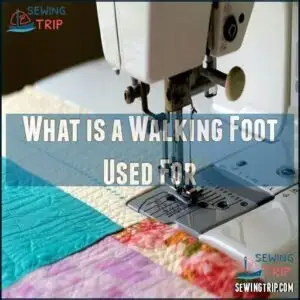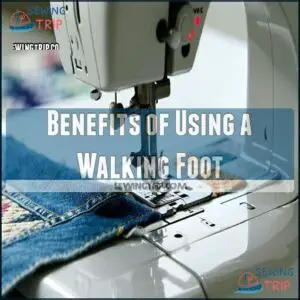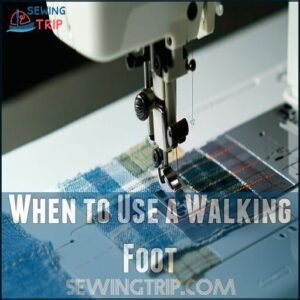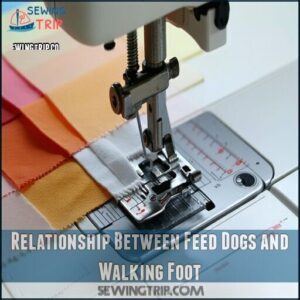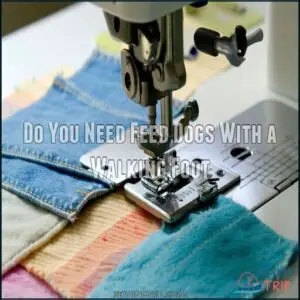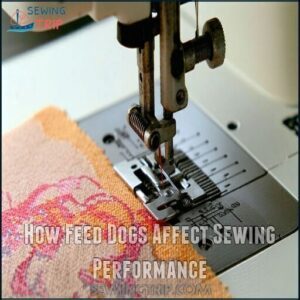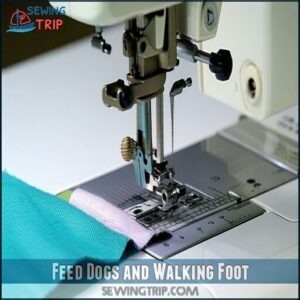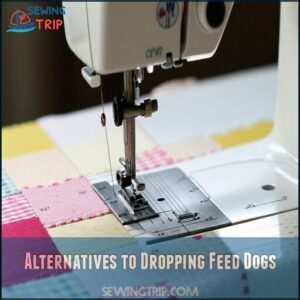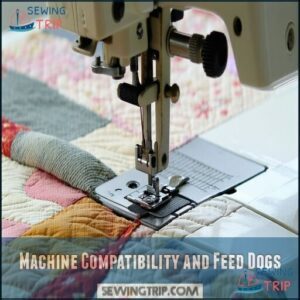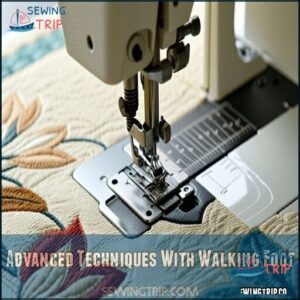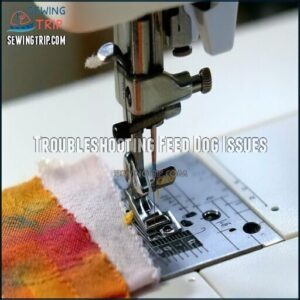This site is supported by our readers. We may earn a commission, at no cost to you, if you purchase through links.
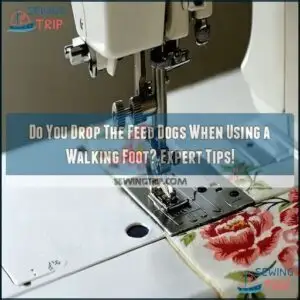 No, you don’t drop the feed dogs when using a walking foot. The walking foot is designed to work with your feed dogs, not replace them.
No, you don’t drop the feed dogs when using a walking foot. The walking foot is designed to work with your feed dogs, not replace them.
Together, they create a synchronized system where the feed dogs move the bottom fabric while the walking foot moves the top layer at the same rate. This prevents layers from shifting and eliminates puckering, especially when working with multiple fabric layers or slippery materials.
Keep those feed dogs engaged to maintain proper tension and stitch quality. Many sewists mistakenly lower their feed dogs, then wonder why their stitches look uneven. Understanding this partnership between components is just the first step to mastering perfect seams.
Table Of Contents
Key Takeaways
- You shouldn’t drop your feed dogs when using a walking foot as they work together as a synchronized system – feed dogs move the bottom fabric while the walking foot handles the top layer at the same rate.
- Your walking foot doesn’t replace feed dogs but enhances their function, creating perfect fabric control that prevents shifting, puckering, and bunching, especially with multiple layers or slippery materials.
- You’ll achieve better stitch quality, even tension, and flawless seam alignment by keeping your feed dogs up and working in partnership with your walking foot.
- You can adjust your stitch length rather than dropping feed dogs if you need more control – shorter stitches (1-2mm) work better for delicate fabrics, while longer stitches (3.5-5mm) are ideal for thicker materials.
What is a Walking Foot
You’ll find a walking foot is a specialized attachment that works with your sewing machine’s feed dogs to move multiple layers of fabric evenly through the machine.
It features its own set of feed dogs on top that work in sync with the machine’s feed dogs underneath, preventing fabric layers from shifting or bunching as you sew, which is a key function of a walking foot to ensure even movement.
What is a Walking Foot Used For
A walking foot is your sewing machine’s problem-solving companion, designed to grip and move multiple fabric layers simultaneously through your machine with precision and ease.
Unlike standard presser feet, this specialized attachment works in harmony with your feed dogs to provide balanced fabric control from both top and bottom, eliminating the frustration of uneven stitching.
Your walking foot excels at:
- Quilting projects requiring perfect seam alignment
- Matching patterns and stripes with unprecedented accuracy
- Taming stretchy knits that typically wiggle and distort
- Managing slippery fabrics like vinyl or silk without bunching
- Creating flawless topstitching where stitch quality matters most
This powerful tool substantially improves thread management while handling layered fabrics, allowing you to tackle challenging projects with professional results. Many sewers find specialized feet invaluable for certain tasks. Think of it as your fabric’s personal escort through the sewing machine—keeping everything perfectly aligned and moving forward together.
Benefits of Using a Walking Foot
Now that you understand what a walking foot is, let’s explore the impressive benefits it brings to your sewing projects.
A walking foot attachment offers remarkable advantages for fabric control when you’re handling multiple layers.
Your fabric feeds through evenly, preventing the frustrating shifting that can ruin careful piecing work.
You’ll notice immediately improved stitch quality across thick materials like denim, vinyl, and quilts.
The walking foot works with your machine’s feed dogs—not against them—creating a synchronized even feed system that eliminates puckering.
Seam alignment becomes noticeably better as layers stay perfectly matched throughout the stitching process.
This makes it ideal for pattern matching and working with slippery fabrics.
Thread management improves too, with fewer tension problems and broken threads.
Many quilters won’t work without one, highlighting the walking foot’s ability to handle varied fabric compatibility.
The walking foot’s ability to handle varied fabric compatibility makes it worth the investment for anyone who sews multiple layers regularly.
When to Use a Walking Foot
Now that you know the benefits, let’s look at when your walking foot really shines.
Your walking foot becomes your best friend in these situations:
- Fabric Thickness: When sewing through multiple layers like quilt sandwiches or denim
- Slippery Fabrics: When working with silk, satin, or vinyl that tends to slide around
- Matching Plaids: When precise pattern alignment is critical for professional results
- Topstitching Uses: When even stitching visibility matters on garment edges
The even feed provided by a walking foot working with your feed dogs guarantees fabric layers move together smoothly.
A walking foot also helps prevent fabric shifting and puckering.
You’ll notice the difference immediately – no more puckering or uneven stitches on layered projects.
How Feed Dogs Work
Your feed dogs work like tiny conveyor belts that grip and move fabric through your sewing machine with each stitch.
They move in an up-forward-down-back motion, synchronized with the walking foot to guarantee even fabric movement without stretching or bunching, utilizing a motion that is also related to the feed dogs’ function as tiny conveyor belts.
Relationship Between Feed Dogs and Walking Foot
Feed dogs and your walking foot create an ideal combination that works in perfect harmony.
Like dance partners, they move together – feed dogs grip from below while the walking foot presses from above, ensuring even fabric feed throughout your project.
This synchronized system maintains fabric control and guarantees consistent stitch quality, particularly when handling multiple layers.
When properly adjusted, this machine harmony prevents puckering and shifting, resulting in flawless seam alignment that professional sewists rely on, which is a result of the perfect harmony between the feed dogs and the walking foot.
Do You Need Feed Dogs With a Walking Foot
Working together with your walking foot, feed dogs are absolutely essential—never drop them during operation.
Your sewing machine needs both mechanisms for proper functionality:
- Feed dogs grip the bottom fabric layer while the walking foot handles the top
- This dual-layer control prevents fabric shifting and puckering
- Even feed creates perfectly aligned seams, especially in multiple layers
- Thread tension remains consistent when both systems work in tandem
- Stitch quality improves dramatically with proper fabric layer control
Think of them as partners—feed dogs move the fabric from below while the walking foot synchronizes from above.
When they work together, your sewing projects gain professional-quality results with minimal effort, and it is crucial to maintain proper functionality for the best outcomes, ensuring even feed and dual-layer control for perfectly aligned seams.
How Feed Dogs Affect Sewing Performance
Your sewing machine’s feed dogs work like tiny conveyor belts, controlling how fabric moves under your needle. When properly adjusted, they substantially impact your stitch quality and overall results.
- Feed dogs grip and advance fabric at consistent rates, preventing bunching or stretching
- Different fabric types require specific feed dog adjustments for ideal control
- Walking foot attachments work in harmony with feed dogs, not against them
- Proper tension balance depends on how feed dogs move material through your machine
For troubleshooting common issues, try adjusting your feed dog height or pressure according to your fabric type’s specific needs, which is crucial for achieving proper tension balance and ensuring your feed dogs work in harmony with other attachments.
Feed Dogs and Walking Foot
You’ll achieve the best results by keeping your feed dogs up when using a walking foot since they work together to move fabric evenly through your machine.
Your walking foot doesn’t replace feed dogs but rather partners with them, creating a synchronized system that prevents fabric layers from shifting or bunching during sewing, which is why they are a crucial partnership.
Do You Drop Feed Dogs With a Walking Foot
Contrary to popular belief, you should keep your feed dogs up when using a walking foot. These two components work together as partners – feed dogs grip the bottom layer while your walking foot handles the top, creating perfectly even fabric feed.
This synchronized movement prevents puckering and shifting, especially essential for complex quilting designs and multi-layered projects. Your sewing machine relies on this balanced team for consistent stitches.
While you’d drop feed dogs for free-motion work, standard walking foot techniques need them engaged. Think of it this way: dropping feed dogs with a walking foot is like trying to drive with half the wheels missing, which highlights the importance of balanced team for consistent stitches.
Benefits of Keeping Feed Dogs Up
Always keep your feed dogs up when using a walking foot for truly even stitching.
The dynamic duo of feed dogs below and walking foot above creates perfect fabric control, where both layers move in harmony.
You’ll notice immediately improved seam alignment as the feed dogs grip the bottom fabric while the walking foot guides the top.
This teamwork prevents slipping and guarantees consistent quality across multiple layers.
Many sewists report fewer headaches with this setup, especially when working with slippery fabrics or quilt sandwiches.
Your machine’s even feed system works best when all components function together, ensuring truly even stitching.
Drawbacks of Dropping Feed Dogs
Dropping the feed dogs when using a walking foot often creates more problems than it solves.
Without the support of the sewing machine feed dogs, you’re likely to face uneven stitching and fabric slippage.
The walking foot is designed to work hand-in-hand with feed dogs to guarantee smooth, consistent fabric movement.
When you disengage the feed dogs, this balance is lost, leading to skipped stitches and frustrating tension problems.
This issue becomes even worse with lightweight or slippery materials, which may pucker, stretch, or even tear.
Additionally, incorrect feed dog adjustment could result in machine damage, cutting your project short.
Dropping the feed dogs also limits your control and increases the effort required to guide fabric evenly.
To avoid these headaches, keep the feed dogs up, letting them do their job in perfect partnership with the walking foot.
Alternatives to Dropping Feed Dogs
You don’t need to drop your feed dogs when using a walking foot as there are several effective alternatives.
You can adjust your stitch length to control feed dog movement or use a free motion glider for smoother fabric handling while keeping your feed dogs engaged.
Setting Stitch Length to Limit Feed Dog Movement
Many sewers don’t realize that adjusting your stitch length offers excellent control without dropping feed dogs when using a walking foot.
When working with your sewing machine, consider:
- Short stitches (1-2mm) for better fabric stability on delicate materials
- Medium stitches (2.5-3mm) for everyday projects with balanced tension adjustments
- Longer stitches (3.5-5mm) for thick fabrics like denim or batting layers
- Zero setting completely limits feed dog movement for manual control
This simple feed dog adjustment gives you precise control over your fabric’s movement, preventing puckering and ensuring even stitches.
I’ve found that a slightly shorter stitch length often creates more professional-looking seams when quilting multiple layers with my walking foot.
Using a Free Motion Glider for Smooth Quilting
While adjusting stitch length helps control feed dogs, a free motion glider offers another excellent solution for quilters.
A free motion glider creates a smooth surface between your fabric and feed dogs. When used with your walking foot, you’ll experience improved fabric control without dropping those feed dogs.
You can find a suitable free motion platform online.
| Glider Benefits | Fabric Control | Stitch Quality |
|---|---|---|
| Reduces friction | Prevents fabric catching | Guarantees even stitches |
| Minimizes drag | Allows easier pivoting | Eliminates puckering |
| Protects feed dogs | Improves movement | Creates professional results |
| Extends machine life | Reduces hand fatigue | Maintains tension |
| Works with all fabrics | Increases precision | Supports creative freedom |
You’ll notice immediately how your quilting feels more like gliding on ice than pushing through mud, which is a result of the smooth surface and even stitches provided by the glider, allowing for easier pivoting and improved movement.
Leaving Feed Dogs Up for Better Stitches
While free motion gliders offer one solution, keeping your feed dogs up when using a walking foot actually creates the perfect partnership for better stitches.
Your feed dogs and walking foot work together like a synchronized team, creating what sewers call an "even feed" system. This combination moves all fabric layers at the same rate, eliminating common headaches.
Here’s why leaving feed dogs up makes sense:
- Consistent stitching without puckering, even on slippery silks or thick quilts
- Superior fabric control that prevents layers from shifting during sewing
- Perfect seam alignment when matching patterns or working with plaids
- Balanced tension across all fabric types, from cotton to denim
Think of it as giving your sewing machine an extra pair of hands to hold your fabric steady while you focus on creating beautiful, professional-looking projects. Regular maintenance helps prevent feed dog problems.
Machine Compatibility and Feed Dogs
Your sewing machine’s model will determine how feed dogs interact with your walking foot attachment.
You’ll need to check your machine’s manual for specific settings, as some machines work best with feed dogs up while others require slight adjustments for ideal fabric feeding, and it is crucial to follow these settings to ensure proper functioning.
Different Machines Respond Differently to Feed Dog Settings
While exploring alternatives to dropping feed dogs, you’ll notice each sewing machine has its own "personality" in feed dog settings with a walking foot.
Vintage Japanese machines often perform best with feed dogs raised, while newer computerized models might need different adjustments.
Machine variations substantially impact how your fabric moves through the machine. Understanding feed dog synchronization is key to achieving ideal stitch quality.
The relationship between your walking foot and feed dogs isn’t one-size-fits-all—industrial machines respond differently than domestic ones. Your machine’s design, age, and feed mechanism all affect how adjustments translate to stitch quality and tension control.
Experimenting With Feed Dog Settings for Best Results
You can dial in your feed dog settings to access better fabric movement. Think of it like finding the sweet spot on your favorite tool—a little tweaking goes a long way!
Try these adjustments for ideal results:
- Vary stitch length (shorter for delicate fabrics, longer for quilting)
- Fine-tune fabric tension control for different materials
- Test differential feed settings on sample swatches
- Match feed dog height to fabric thickness
Your walking foot works best when feed dogs are properly adjusted to your specific project needs, allowing for better fabric movement and ensuring the feed dogs are set correctly.
Machine Compatibility Affects Free Motion Quilting Success
Your machine’s unique personality impacts free motion quilting success.
Not all sewing machines handle feed dogs and walking foot combinations the same way.
| Machine Type | Feed Dog Position | Best Results |
|---|---|---|
| Computerized | Up | Precise stitch regulation |
| Mechanical | Down | Better fabric control |
| Hybrid | Adjustable | Versatile quilting options |
Test your machine’s tension balance and foot compatibility to discover what works.
Sometimes keeping feed dogs up with a walking foot yields better quilting precision than traditional techniques, which can lead to better fabric control and precise stitch regulation.
Advanced Techniques With Walking Foot
You’ll tap into your walking foot’s full potential with these advanced techniques that go beyond basic straight-line stitching.
Your feed dogs and walking foot work together as a team, creating professional results for complex quilting patterns and multi-layered projects.
Using a Walking Foot for Complex Quilting Designs
While different machines respond to feed dogs in unique ways, let’s look at how your walking foot can handle complex quilting designs.
Feed dogs and walking feet dance together, creating harmony on fabric that ordinary feet only dream about.
The walking foot takes your quilting skills beyond basic straight lines. You’ll keep those feed dogs up while your walking foot guides multiple fabric layers with perfect precision.
When tackling intricate designs, your walking foot becomes an invaluable partner:
- Even stitches across curved cathedral window patterns without fabric bunching
- Smooth corner passages when traversing complicated appliqué borders
- Consistent tension when creating wave-like parallel lines across your quilt sandwich
- Perfect fabric manipulation for gentle serpentine stitches without puckering
Walking foot mastery means you can attempt more complex designs without fighting fabric movement.
Regular maintenance helps guarantee performance.
Your quilts will display professional-quality stitch regulation that makes intricate design sewing a pleasure rather than a challenge.
Tips for Free Motion Quilting With a Walking Foot
While complex designs showcase your creativity, free motion quilting with a walking foot requires specific technique adjustments for success.
You’ll want to maintain proper hand positioning parallel to your lap while keeping your shoulders relaxed. Good posture prevents fatigue during longer quilting sessions and improves your control over the fabric.
For best results, keep your feed dogs up when using a walking foot—they work together to move layers evenly. Adjust foot pressure based on fabric thickness; lighter pressure works better for bulkier quilts.
Balance machine speed with hand movement for smooth stitches, and pay attention to thread tension to prevent puckering.
Choose fabrics wisely—slippery materials can be frustrating for beginners. A Supreme Slider positioned correctly (never over feed dogs) will help your quilt glide smoothly as you work.
Advanced Techniques for Walking Foot and Feed Dogs
Experienced quilters know that walking foot mastery requires clever feed dog collaboration.
When attempting curved piecing or trapunto quilting, keep feed dogs up for ideal fabric movement. Try echo quilting by adjusting your walking foot’s even feed to maintain consistent fabric manipulation.
For decorative stitching, slightly reduce feed dog height while increasing presser foot pressure. Watch how the layers glide together without shifting!
When tackling challenging materials, experiment with feed dog adjustment rather than dropping them completely—you’ll achieve professional results with minimal effort, using clever feed dog collaboration and walking foot mastery to ensure success.
Troubleshooting Feed Dog Issues
You’ll notice when your feed dogs aren’t working properly because your fabric won’t move smoothly through the machine.
When paired with a walking foot, troubleshooting feed dog issues involves checking that they’re properly engaged and free from lint or debris that might block their movement, which can be a key step in resolving the issue with your feed dogs.
Common Issues With Feed Dogs and Walking Foot
Many sewists encounter frustrating roadblocks when using walking feet with feed dogs.
Here are three common issues you’ll likely face:
- Fabric slippage – Layers shift because of improper tension between walking foot and feed dogs
- Skipped stitches – Poor connection between walking foot and feed dogs interrupts the proper fabric movement
- Thread breakage – Uneven tension causes threads to snap when fabric feeding becomes inconsistent
Regular machine calibration helps maintain smooth cooperation between these essential components.
Addressing walking foot slipping can improve fabric control.
Solutions for Feed Dog Problems
Your sewing machine’s feed dog problems have simple solutions.
To fix skipped stitches, raise and clear feed dogs of debris between the needle plate.
For fabric slippage, adjust feed dog height with slight clearance on all sides.
Replace worn feed dogs if fabric movement is inconsistent.
Lubricate the feed dog mechanism overnight, ensuring the base plate moves freely.
Experiment with different stitch lengths to minimize feed dog issues and improve walking foot performance.
Preventing Feed Dog Issues With Walking Foot
Now that you’ve learned how to solve feed dog problems, let’s focus on preventing issues before they start.
Maintaining trouble-free operation between your feed dogs and walking foot isn’t complicated once you know what to watch for.
Regular inspection of your machine’s settings forms the foundation of problem prevention.
- Match your foot pressure to your fabric type – heavier fabrics need more pressure, delicate fabrics need less.
Your feed dog adjustment works hand-in-hand with fabric tension to create stitch consistency.
Check that your needle type and thread quality complement your project materials.
Clean your walking foot regularly to remove lint that can interfere with fabric movement.
Sometimes it’s as simple as using a small brush to clear debris from between those metal teeth.
Remember, proper maintenance saves you frustration and keeps your sewing machine humming along smoothly.
Frequently Asked Questions (FAQs)
Do You Drop the feed dogs when using a walking foot?
No, you don’t drop the feed dogs when using a walking foot.
They work together – the walking foot supplements the feed dogs to move multiple layers of fabric evenly, preventing bunching or shifting.
Do you need to drop feed dogs?
No, you don’t need to drop feed dogs for most sewing tasks.
They should remain up for regular sewing and when using a walking foot, as they work together to move fabric evenly.
What happens if you drop a feed dog?
Like a car without wheels, your fabric won’t move forward if you drop feed dogs.
You’ll lose the grip that pushes fabric through your machine, making normal stitching impossible without manual guidance, because drop feed dogs will hinder the process.
Do I need a feed dog for free motion quilting?
For free motion quilting, you’ll want to drop your feed dogs.
This gives you complete control over the fabric movement, allowing you to create custom patterns and designs as you guide the fabric manually.
Can You Drop a feed dog on a sewing machine?
Yes, you can drop feed dogs on most modern sewing machines using a specific lever or switch.
It’s typically located underneath the free-arm bed on the backside of your machine or accessible through the accessories compartment, which can be a key location to remember.
Can a walking foot be used for backstitching?
The walking foot, like a steady ship on fabric seas, can handle backstitching but with limitations.
You’ll find it works, though movement may feel stiffer than with regular presser feet.
Try slow, deliberate stitches.
Should feed dogs be up or down when sewing?
Feed dogs should typically remain up when sewing standard projects.
They grip and move fabric through your machine.
Only lower them for specific techniques like free-motion quilting where you’ll manually control fabric movement, especially in situations that require precise fabric control.
Do you drop the feed dogs when quilting?
It depends on your quilting technique. For straight-line quilting, keep feed dogs up with your walking foot. For free-motion quilting, drop them so you can control the movement manually.
Does a walking foot have a feed dog?
Like a hidden helper beneath the surface, a walking foot does indeed have its own feed dogs.
They work alongside your machine’s built-in feed dogs to move all fabric layers evenly through your project.
How do feed dogs work?
Your sewing machine’s feed dogs function like tiny conveyor belts.
They’re the metal teeth beneath your needle plate that move up and down, gripping your fabric and pulling it through as you sew.
Conclusion
Remember, while many beginners wonder "do you drop the feed dogs when using a walking foot," the answer is clearly no.
Your feed dogs and walking foot work as partners, not competitors. You’ll achieve smoother seams, better tension, and professional results by keeping those feed dogs engaged.
Trust this system that’s designed to work together, and you’ll notice immediate improvements in your quilting and sewing projects. Your machine was engineered this way for a reason—embrace it and enjoy the professional results!
- https://www.youtube.com/watch?v=c76bGia5Rds
- https://leatherworker.net/forum/topic/72507-walking-foot-material-feed-problem-shifting/
- https://forum.missouriquiltco.com/forum/we-don-t-know-much-but-we-know-quilters/quilting-questions/65877-dropping-feed-dogs
- https://www.reddit.com/r/sewhelp/comments/sn7w12/brother_xl2600i_feed_dogs_and_walking_foot/
- https://www.quiltingboard.com/main-f1/feed-dogs-up-down-t211387.html

